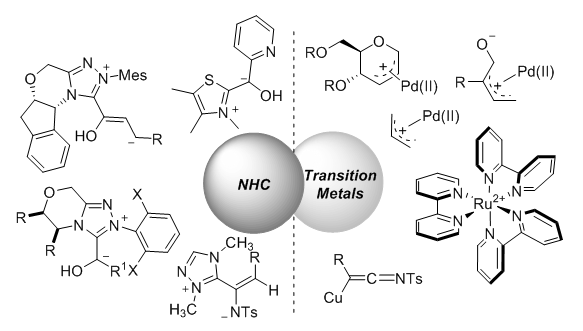| [1] (a) Shao, Z.; Du, Z. Chem. Soc. Rev. 2013, 42, 1337.
(b) Sun, Z.; He, J.; Qu, M.; Li, K. Chin. J. Org. Chem. 2015, 35, 1250. (孙哲, 何金梅, 屈孟男, 李侃社, 有机化学, 2015, 35, 1250).
[2] (a) Song, J.; Zhang, Z.-J.; Gong, L.-Z. Angew. Chem. Int. Ed. 2017, 19, 5212.
(b) Song, J.; Zhang, Z.-J.; Chen, S.-S.; Fan, T.; Gong, L.-Z. J. Am. Chem. Soc. 2018, 140, 3177.
(c) Zhu, S.; Xu, L.; Wang, L.; Xiao, J. Chin. J. Org. Chem. 2016, 36, 1229. (朱帅, 徐鲁斌, 王亮, 肖建, 有机化学, 2016, 36, 1229).
(d) Li, B.; Liu, R.; Liang, R.; Jia, Y. Acta Chim. Sinica 2017, 75, 448. (李保乐, 刘人荣, 梁仁校, 贾义霞, 化学学报, 2017, 75, 448).
[3] (a) Flanigan, D. M.; Romanov-Michailidis, F.; White, N. A.; Rovis, T. Chem. Rev. 2015, 115, 9307.
(b) Zhao, M.; Zhang, Y.-T.; Chen, J.; Zhou, L. Asian J. Org. Chem. 2018, 7, 54.
(c) Wang, A.; Xiao, Y.; Zhou, Y.; Xu, J.; Liu, H. Chin. J. Org. Chem. 2017, 37, 2590. (王翱, 肖永龙, 周宇, 徐进宜, 柳红, 有机化学, 2017, 37, 2590).
[4] (a) Cohen, D. T.; Scheidt, K. A. Chem. Sci. 2012, 3, 53.
(b) Wang, M. H.; Scheidt, K. A. Angew. Chem. Int. Ed. 2016, 55, 14912.
[5] Nemoto, T.; Fukuda, T.; Hamada, Y. Tetrahedron Lett. 2006, 47, 4365.
[6] (a) Lebeuf, R.; Hirano, K.; Glorius, F. Org. Lett. 2008, 10, 4243.
(b) He, J.; Tang, S.; Tang, S.; Liu, J.; Sun, Y.; Pan, X.; She, X. Tetrahedron Lett. 2009, 50, 430.
[7] Bai, Y.; Xiang, S.; Leow, M.; Liu, X.-W. Chem. Commun. 2014, 50, 6168.
[8] Bai, Y.; Leng, W. L.; Li, Y.; Liu, X.-W. Chem. Commun. 2014, 50, 13391.
[9] Liu, K.; Hovey, M. T.; Scheidt, K. A. Chem. Sci. 2014, 5, 4026.
[10] Guo, C.; Fleige, M.; Janssen-Müller, D.; Daniliuc, C. D.; Glorius, F. J. Am. Chem. Soc. 2016, 138, 7840.
[11] Guo, C.; Janssen-Müller, D.; Fleige, M.; Lerchen, A.; Daniliuc, C. D.; Glorius, F. J. Am. Chem. Soc. 2017, 139, 4443.
[12] Singha, S.; Patra, T.; Daniliuc, C. D.; Glorius, F. J. Am. Chem. Soc. 2018, 140, 3551.
[13] Yasuda, S.; Ishii, T.; Takemoto, S.; Haruki, H.; Ohmiya, H. Angew. Chem. Int. Ed. 2018, 57, 2938.
[14] Namitharan, K.; Zhu, T.; Cheng, J.; Zheng, P.; Li, X.; Yang, S.; Song, B.-A.; Chi, Y. R. Nat. Commun. 2014, 5, 3982.
[15] Chen, J.; Yuan, P.; Wang, L.; Huang, Y. J. Am. Chem. Soc. 2017, 139, 7045.
[16] DiRocco, D. A.; Rovis, T. J. Am. Chem. Soc. 2012, 134, 8094. |
